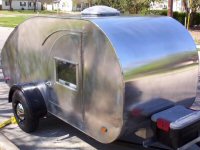Hello!
This is my first post and I'm hoping to get some advice/help! I am converting a beautiful new cargo trailer into a camper/toy hauler. It is a 6x12 v-nose with ramp from Cargo Outlet (GA). The build quality is great. The problem is... no insulation in the walls. I should have had it installed at the factory and I just overlooked it when ordering.
CLIFF'S NOTES SUMMARY FOR THE TL/DR TYPES:
No insulation in the walls -- Should I leave it as is and hope for the best, do a full tear down, or try something else?
The trailer has two windows, a fuel hatch (for window AC), and an RV-style door installed already. The walls are sheets of plywood screwed into the metal struts. There is stripping over the top of the plywood which is stapled down and glued (liquid nails, possibly). Due to all the stuff in the walls and the stripping, I'm pretty sure that tearing down the plywood to do a standard foam-panel install for insulation is going to be a mess. I think I will probably destroy most of the plywood in the process, and I'm worried about the doors/windows/hatch areas in particular.
I do plan on doing the best I can with the roof. I have the special white RV roof paint and I was planning on a false ceiling with ~2" of insulation up top. I have a Fantastic Vent roof van and a second unpowered roof vent for ventilation. On shore power I will have a 5000 BTU window AC. The trailer will primarily be used in the hot, humid southeast and possibly in the arid desert southwest. I'd like to be able to do some boondocking, relying on the roof fan, an endless breeze fan, and maybe a swamp cooler (in the desert). I hope to get at least 5-6 years out of it before I upgrade to something else.
I was wondering if anyone has any advice among these insulation options, or something I haven't thought of yet.
LEAVE IT AS IS
Hopefully the good insulation job on the ceiling will be sufficient. The rear ramp door, single pane windows, and big RV door were going to be insulation problems anyways.
I am just really concerned that I'm going to have a beautiful custom trailer which I've invested a fair amount of additional work into for other systems (electrical, beds, cabinets, etc) that ends up being unusable because it isn't insulated properly.
If anyone has an un-insulated trailer and can share their experience that'd be helpful!
TRADITIONAL TEAR DOWN WITH POLYISO PANEL INSTALL
I think this will destroy much of the plywood. I'm worried about the existing doors/windows as well. On the plus side, we know that the polyiso board install works, and I have nice 1" struts with plenty of space.
FURRING WITH FALSE WALL
I could put in some 1x1" boards on top of the current 3/8" plywood walls, fill the space with polyiso boards, and then put 1/2" plywood over top. This avoids any damage or structural problems with the window/door. It does cost me 3" of interior space, and is somewhat expensive and time consuming.
GREEN FIBER BLOW IN INSULATION
I know that traditional fiberglass insulation is a Bad Idea in trailers as it settles and is scratchy/nasty to breathe. I was looking at this "GreenFiber" stuff which is also a blow-in style.
http://www.greenfiber.com/
It would likely also settle in the walls but at least it isn't nasty to breathe, nor is it itchy. Even though it settles it would be better than what I have now (i.e. nothing). I could use a circular saw screwdriver bit to put some holes in the plywood wall and then blow in the insulation. Glue the plywood circles back into place with some caulk/dicor and it should be all sealed up again.
ROXUL BATTING
Roxul is a mineral wool. I have access to the top of a few of the panels so I could potentially slide some batting down inside. I could also drill the circular holes as with the green fiber blow-in install and stuff as much batting in as possible. The biggest issue I see is that it is 3.5" thick and I only have 1" to work with behind the plywood.
EXPANDABLE FOAM
I thought about putting a bunch of cans of the stuff in there, or hiring a pro to squirt some in, but I have concerns about gaps (moisture/rot areas), bulging out the aluminum sides, or causing structural problems if the foam doesn't allow any flex.
CLOSED CELL FOAM CAMPING PADS
I have access to the top of a few panels. I was thinking of sliding flexible closed cell foam sleeping pads (1/2") down into the spaces, perhaps with some weights (or a string pulled through a hole at the bottom of the panel). The R-value on this will be low but it is easy.
Thanks for any advice or thoughts on the issue!
Insulation Problem -- am I hosed?
13 posts
• Page 1 of 1
Re: Insulation Problem -- am I hosed?
When I did my 6X14 I took everything down (plywood) and put in the pink foam and then used. Great stuff where there were gaps
PaulS
- PaulS
- Teardrop Master
- Posts: 101
- Images: 0
- Joined: Sat Dec 22, 2012 2:31 pm
- Location: Michigan

 I personally don't see that your screwed. I have used one of these,
I personally don't see that your screwed. I have used one of these, 



